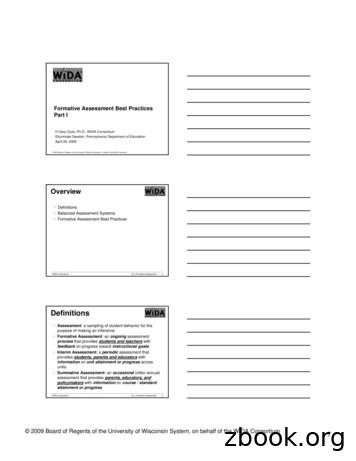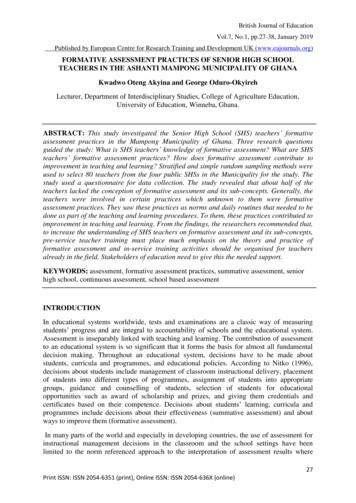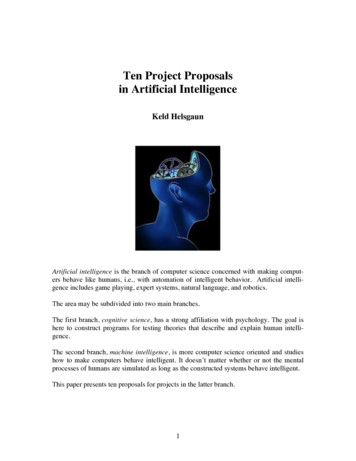Embedded Formative Assessment - Amazon Web Services
Embedded Formative AssessmentBy Dylan WiliamStudy GuideThis study guide is a companion to the book Embedded Formative Assessment by Dylan Wiliam.Embedded Formative Assessment outlines what formative assessment is, what it is not, andpresents the five key strategies of formative assessment for teachers to incorporate into theirregular classroom practice.This guide is arranged by chapter, enabling readers to either work their way through the entirebook or to focus on the specific topics addressed in a particular chapter. It can be used byindividuals, small groups, or by an entire team to identify key points, raise questions forconsideration, assess conditions in a particular school or district, and suggest steps that might betaken to ultimately increase educational achievement.We thank you for your interest in this book, and we hope this guide is a useful tool in yourefforts to increase student achievement in your school or district.Copyright 2011 by Solution Tree Press--1--
Embedded Formative Assessment—Study GuideChapter 1Why Educational Achievement Matters1. How is the economy influencing education and graduation rates?2. Why is education, rather than training, important to students’ economic stability?3. What impediments have stopped or hindered school reform?4. Identify the different levels of curriculum. Which has the greatest impact on studentachievement?5. What role do computers have in education? How are they used in your classroom?6. What, according to the author, is the critical element that defines how students learn?7. What effect does teacher quality have on student progress?8. How can teacher quality be increased?Copyright 2011 by Solution Tree Press--2--
Embedded Formative Assessment—Study GuideChapter 2The Case for Formative Assessment1. What kinds of improvement strategies have the best impact on student outcome?2. What is the relationship between the teacher’s level of experience and student learning?3. What is the drawback of state requirements that ask teachers to stay up to date with thelatest developments in the field?4. What are the popular focus areas for professional development? Which would be mosteffective for your classroom?5. How does learning in a style other than the students’ preferred styles affect theirknowledge retention?6. What is formative assessment? How does it contrast with summative evaluation?7. Can any assessment be considered formative? Why or why not?8. Identify the three key processes and three individuals involved with teaching.9. What are the five key strategies of formative assessment?10. Why is assessment the central process in instruction?Copyright 2011 by Solution Tree Press--3--
Embedded Formative Assessment—Study GuideChapter 3Clarifying, Sharing, and Understanding Learning Intentions and SuccessCriteria1. Why is clarifying learning intentions critical to students’ and educators’ success?2. What is the wallpaper objective?3. When is stating learning intentions useful?4. Why is developing learning intentions with students advantageous?5. What three issues must be considered when developing learning intentions and successcriteria?6. What points should be kept in mind when introducing students to disciplines?7. What are some techniques for helping students understand learning intentions andsuccess criteria? Which would be useful in your classroom?8. When is it appropriate to simply present the learning intentions and success criteria tostudents?Copyright 2011 by Solution Tree Press--4--
Embedded Formative Assessment—Study GuideChapter 4Eliciting Evidence of Learners’ Achievement1. What points should educators focus on when assessing what students know?2. What points should teachers focus on when generating questions that provide a windowinto student thinking?3. According to the author, what are the only two reasons to ask questions in class? Dothese reasons motivate questions you currently ask in your class?4. What influence does the “Matthew effect” have on student achievement?5. What alternatives to questions can teachers employ to generate good classroomdiscussions?6. Which technique(s) for selecting students at random would work best in your classroom?7. What is hot-seat questioning? Is it a viable option for your classroom?8. When is the best time to use exit pass questions?9. Compare and contrast discussion questions and diagnostic questions. Under whatcircumstances should they be used?Copyright 2011 by Solution Tree Press--5--
Embedded Formative Assessment—Study GuideChapter 5Providing Feedback That Moves Learning Forward1. What kinds of feedback are used in your classroom? How effective do you think it is forhelping students improve?2. What kinds of feedback from the chapter can you use in your classroom?3. Why is it necessary that feedback that includes praise is related to factors within anindividual’s control?4. What effect does timing have on the usefulness of feedback?5. What types of feedback lower student performance? How can it be avoided?6. When student performance surpasses feedback goals, what are the four ways the studentcan respond? In what ways can a student who fails to meet the feedback goal respond?7. Under what circumstances can feedback function formatively?8. Why should grades be given infrequently?9. Which practical techniques for providing students with helpful feedback can you use inyour classroom?Copyright 2011 by Solution Tree Press--6--
Embedded Formative Assessment—Study GuideChapter 6Activating Students as Instructional Resources for One Another1. Identify and explain the four factors that influence the success of cooperative learning.2. What effects do peer tutoring have on student success?3. What two elements must be present in cooperative learning for it to be successful?4. What is the C3B4ME technique?5. What is the benefit of using peer evaluation to check homework?6. What techniques can teachers use to motivate students to ask end-of-topic questions?7. What is the preflight checklist? Under what circumstances is it best to use this technique?8. How can educators involve able/proficient students in cooperative learning?9. What practical techniques do you use in your classroom? Which can you adopt?Copyright 2011 by Solution Tree Press--7--
Embedded Formative Assessment—Study GuideChapter 7Activating Students as Owners of Their Own Learning1. What is student self-assessment?2. Does student self-assessment have the potential to raise achievement? Explain.3. What is the basic idea of self-regulated learning?4. What role does metacognition and motivation play in self-regulated learning?5. What is the drawback of intrinsic motivation?6. How can teachers use dual-processing to integrate motivational and cognitiveperspectives on self-regulated learning?7. How can you employ the techniques that are specifically designed to encourage studentsto reflect upon their own learning in your classroom?Copyright 2011 by Solution Tree Press--8--
--1-- Embedded Formative Assessment By Dylan Wiliam _ Study Guide This study guide is a companion to the book Embedded Formative Assessment by Dylan Wiliam. Embedded Formative Assessment outlines what formative assessment is, what it is not, and presents the five key strategies of formative assessment for teachers to incorporate into their
Performance Assessment Score Feedback Formative 1 Date . Formative 2 Date : Formative 3 Date . Formative 4 Date : Formative 5 Date . Formative 6 Date : Summative Date Implements learning activities aligned to chosen standards and incorporates embedded formative assessment. Clearly conveys objectives in student-friendly language so that the
assessment. In addition, several other educational assessment terms are defined: diagnostic assessment, curriculum-embedded assessment, universal screening assessment, and progress-monitoring assessment. I. FORMATIVE ASSESSMENT . The FAST SCASS definition of formative assessment developed in 2006 is “Formative assessment is a process used
Formative Assessment Best Practices Part I H Gary Cook, Ph.D., WIDA Consortium Elluminate Session, Pennsylvania Department of Education April 28, 2009 WIDA Consortium ELL Formative Assessment 2 Overview Definitions Balanced Assessment Systems Formative Assessment Best Practices ELL Formative Assessment 3 Definitions
assessment professional learning system. They are stepping stones along the path. Part I. Learn About Formative Assessment 1.1 Inventory your comprehensive assessment system. 1.2 Clear up misconceptions about formative assessment. Part II. Plan For Formative Assessment 2.1 Identify elements of formative practice that you do well and those you
FORMATIVE ASSESSMENT Formative assessment is any assessment that is used to improve teaching and learning. Assessment is a three-step process by which evidence is collected, interpreted and used. Best-practice formative assessment uses a rigorous approach in which each step of the
An assessment practice is only truly “formative” if the data is used to inform instructional practice and provide support to ensure student success. To learn more about formative assessment practices, visit the D PI Formative Assessment website, or utilize the Formative Assessment Professional Learning Modules .
formative assessment. Theoretical framework of the study Looking for a working description for formative assessment alongside summative assessment in the school setting, Madison-Harris, Muoneke and Times (2012) reviewed series of literature on formative assessment and concluded that "it is a systematic, continuous process
Artificial intelligence is the branch of computer science concerned with making comput-ers behave like humans, i.e., with automation of intelligent behavior. Artificial intelli- gence includes game playing, expert systems, natural language, and robotics. The area may be subdivided into two main branches. The first branch, cognitive science, has a strong affiliation with psychology. The goal is .























